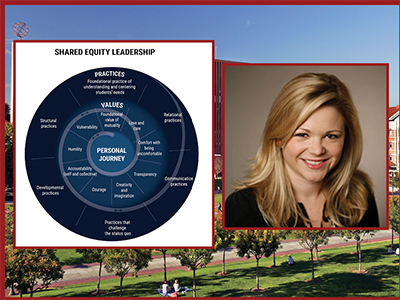A Conversation with USC’s Elizabeth Holcombe
Over the past three years, the Pullias Center and our partner, the American Council on Education (ACE), have been building an impressive library of work all detailing the concept of Shared Equity Leadership (SEL). Our first two reports, “Shared Equity Leadership: Making Equity Everyone’s Work” and “Organizing Shared Equity Leadership: Four Approaches for Sharing the Work,” funded by the Alfred P. Sloan Foundation, were soon followed by reports that focused on various aspects of implementing SEL such as accountability, different roles, capacity building and emotional labor. All the reports, plus the SEL Toolkit, focus on different aspects of SEL and how institutions might embrace it to promote DEI on their campuses without attracting the ire of those who wish to dismantle DEI entirely. Our most recent report, “Emotional Labor in Shared Equity Leadership Environments: Creating Emotionally Supportive Spaces,” was released in June, 2023.
Thanks to the Arthur Vining Davis Foundations, the SEL project has now completed Phase 2 of the years-long project, which explored how campuses were structuring and organizing the work, and other key questions. The team is now beginning Phase 3, which will support campuses just starting their SEL journey.
We recently sat down with Elizabeth Holcombe, Senior Postdoctoral Scholar at the Pullias Center and one of the reports’ authors who has been intricately involved in all phases of the work, to share her thoughts on the various aspects of the SEL project.
Q: Please provide an overview of the Phase 2 SEL work.
Elizabeth Holcombe: In Phase 1, we were trying to understand what approaches campuses take to move forward an equity agenda and move toward culture change. What emerged was a new phenomenon called shared equity leadership which we were able to provide an overview about. After interviewing 63 leaders across eight campuses for that phase, we felt like we were still barely scratching the surface of what there was to learn about this approach. So in Phase 2, we were following up on some key questions or issues that arose during Phase 1. We knew that campuses were more broadly sharing leadership responsibility for DEI, but how exactly were they structuring or organizing that work? How were they thinking about accountability in these new leadership environments? Did the SEL approach look different for leaders in different roles on campus? How were campuses building to capacity to work in this way? And how were they managing the emotions and emotional labor involved in doing DEI work in these more collective environments? Those were the key questions we were hoping to answer in Phase 2. We went back to five of the eight campuses that were a part of Phase 1 and we interviewed a bigger group of leaders including faculty, staff, administrators, students and community leaders on each of those campuses — another 63 leaders. We ended up publishing five additional reports over the course of 2022 and 2023. Each report also has an embedded toolkit or set of reflection questions for leaders to think through the report’s insights or apply them in their own context.
Q: What do you think have been the most exciting insights from the Phase 2 research?
Elizabeth Holcombe: There were a lot! First, there are multiple ways to structure or organize the work that campuses in our study used. Some were more similar to traditional organizational models centered around a Chief Diversity Officer (CDO) and DEI office, while others were more novel, matrix-like structures. One model was not necessarily better or more effective than the others, but some models did seem to be better fits for certain types of campuses than others. For example, the “highly structured model,” in which there are many layers and levels of DEI positions distributed throughout the organization that are connected through some sort of central organizing office or group, seemed to be a particularly good fit for larger, more decentralized or larger campuses where different offices might have quite distinct goals and approaches to the work. More formal structure may be needed on these campuses that have a lot of different things going on in different places.
Second, we found that SEL requires rethinking traditional approaches to accountability. Campuses were not throwing out existing accountability mechanisms but rather expanding them. They were expanding their conception of who was accountable for DEI work, who they were accountable to, what they were accountable for and how they were held accountable. For example, rather than just a CDO or DEI office being accountable for DEI goals, responsibility for meeting DEI goals was now distributed and embedded in more people’s job descriptions. Rather than just thinking about external accountability to boards and legislatures and accreditors, campuses were thinking about how they hold themselves accountable to community members and families and one another. Instead of just measuring outcomes like graduation or persistence, campuses were adding measures of process and climate, and they were building these measurements in on an ongoing basis rather than at just a single point in time.
Third, we found that leaders’ different roles may position them to enact particular values and practices especially well. We looked at leaders’ roles both in terms of their level in the organizational hierarchy and their functional role or job category. For example, senior-level leaders are well-positioned to enact practices like diminishing hierarchy or some of the structural practices such as hiring diverse leaders or rethinking rewards and incentives. Grassroots or ground-level leaders were more dependent on relational practices like building trust or cultivating positive relationships. In terms of leaders’ functional roles, faculty were well-equipped to implement the developmental practices such as learning and helping others learn, while student affairs staff were especially focused on centering students’ needs and listening.
Fourth, campuses built capacity for SEL in a couple of different ways. They had to build capacity for DEI work specifically, as well as for shared leadership. And they had to think about building capacity at different levels — personal, collective and organizational. Effective personal capacity building strategies included trainings and workshops, as well as coaching, mentoring and peer feedback. Collective capacity building approaches included professional learning communities and communities of practice, affinity groups and healing circles. And organizational capacity building involved hiring and promoting diverse leaders, creating new incentive and reward structures, rethinking messaging and communication processes, and building new cross-cutting structures that allowed the work to happen. Generally, campuses struggled more with building collective and organizational capacity and building capacity for shared leadership than they did with building personal capacity and capacity for DEI work.
Fifth, while SEL did not eliminate the emotional labor involved in doing DEI work, leaders felt more supported in their emotions when doing the work collectively. Specifically, SEL helped leaders save the emotional labor of “making the case” for the importance of DEI work, and it created supportive spaces for leaders to work through challenging emotions together rather than in isolation. Finally, we are finishing up the last of our Phase 2 analysis, funded by the TIAA Institute, examining challenges and considerations for implementing SEL. A report on that research should be out sometime next year.
Q: Please share what the plans are for Phase 3 of the SEL work? What will the research focus on?
Elizabeth Holcombe: As we have shared the SEL model more widely, leaders across the country have been asking for specific information on how to get started in implementing SEL on their own campuses. Because the campuses that we studied in the first 2 phases were further along in their SEL journeys, we don’t have a lot of detail on how they got started in the work. So in Phase 3, we are hoping to use the tools we created in Phases 1 and 2 to support a set of campuses on their journeys to start SEL. Along the way, we will study their experiences and hopefully learn lessons about what readiness looks like, how to select the right organizational structure, who should be on the leadership team, how to garner buy-in and widespread support, and more. The goal is to gain insights that will help us spread SEL to as many campuses as are interested in implementing it. Additionally, given the dramatic shift in the political climate around DEI since our initial research took place in 2020-2021, we want to understand how leaders are navigating this new reality. We hope to learn about how SEL can be helpful or how it might need to change in politically hostile environments.
In 2021, we featured interviews with graduate students working on the project. Read more about their experiences here.








